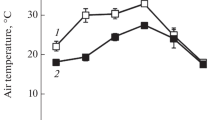Abstract
Environmental factors affecting photosynthetic activity of the typical vernal speciesErythronium japonicum Decne were examined on the floor of a deciduous broad-leavedQuercus mongolica forest (Q.m. stand) and on bare land left undisturbed for 4 years after forest clearing (bare stand). Daytime solar irradiation and air and leaf temperatures at the bare stand were significantly higher than those at theQ.m. stand. The relative air humidity was very low and did not differ much between the stands, although the leaf-air vapor pressure differences (VPD) at the bare stand were about twice as high as those at theQ.m. stand. The plants at both stands were supplied with sufficient soil water throughout their growing season by a large snowmelt. However, the aboveground parts of the plants at the bare stand were subjected to much more severe heat stress, caused by the strong radiations and high leaf temperatures, and water stress, caused by the highly transpiring conditions, than those at theQ.m. stand. When the radiation on leaves, leaf temperatures and VPD in the assimilation chamber were changed from those observed at theQ.m. stand to those at the bare stand, the photosynthetic rate and stomatal conductance fell significantly. However, the rate and conductance were immediately restored to the respective values near those measured under the conditions at theQ.m. stand when only VPD was dropped to the value similar to that observed at theQ.m. stand. These results indicate that the photosynthetic rate of the plants at the bare stand was lowered largely by a decrease in stomatal conductance. The internal CO2 partial pressure\((P_{CO_2} )\) was considerably greater in leaves placed under environmental conditions similar to those at the bare stand.
Similar content being viewed by others
References
Bjorkman O. &Holmgren P. (1963) Adaptability of the photosynthetic apparatus to light intensity in ecotypes from exposed and shaded habitats.Physiologia Plantarum 16: 889–914.
Forseth I. N. &Ehleringer J. R. (1983) Ecophysiology of two solar tracking desert winter annuals. III. Gas exchange responses to light, CO2 and VPD in relation to long-term drought.Oecologia 57: 344–351.
Gaastra P. (1959) Photosynthesis of crop plants as influenced by light, carbon dioxide, temperature and stomatal diffusion resistance.Mededelingen van de Landbouwhogeschool te Wageningen, Nederland 59: 1–68.
Hirasawa T., Iida Y. &Ishihara K. (1989) Dominant factors of photosynthetic rate affected by air humidity and leaf water potential in rice plant.Japanese Journal of Crop Science 58: 383–389 (in Japanese).
Kawamitsu Y., Yoda S. &Agata W. (1993) Humidity pretreatment affects the responses of stomata and CO2 assimilation to vapor pressure difference in C3 and C4 plants.Plant and Cell Physiology 34: 113–119.
Kawano S., Hiratsuka A. &Hayashi K. (1982) Life history characteristics and survivorship ofErythronium japonicum. The productive and reproductive biology of flowering plants V.Oikos 38: 129–148.
Kirschbaum M. U. F. &Pearcy R. W. (1988) Gas exchange analysis of the relative importance of stomatal and biochemical factors in photosynthetic induction inAlocasia macrorrhiza.Plant Physiology 86: 782–785.
Koizumi H. &Oshima Y. (1985) Seasonal changes in photosynthesis of four understory herbs in deciduous forests.Botanical Magazine, Tokyo 98: 1–13.
Moss D. N. &Rawlins S. L. (1963) Concentration of carbon dioxide inside leaves.Nature 197: 1320–1321.
Sawada S., Igarashi T. &Miyachi S. (1982) Effects of nutritional levels of phosphate on photosynthesis and growth studied with single, rooted leaf of dwarf bean.Plant and Cell Physiology 23: 27–33.
Sawada S. &Sugai M. (1984) Responses of transpiration and CO2 exchange characteristics to soil moisture stress in fourPlantago species.Photosynthetica 18: 34–42.
Sawada S., Chida S., Sawaguchi Y. &Nagasawa N. (1997) Dry matter production, population structure and environmental conditions of the spring ephemeralErythronium japonicum growing in various habitats differing in sunlight exposure in cool temperature Japan.Ecological Research 12: 89–99.
Sparling J. H. (1964) Ontario's woodland flora.Ontario Naturalist 2: 18–25.
Sparling J. H. (1967) Assimilation rates of some woodland herbs in Ontario.Botanical Gazette 128: 160–168.
Taylor R. J. &Pearcy R. W. (1975) Seasonal patterns of the CO2 exchange characteristics of understory plants from a deciduous forest.Canadian Journal of Botany 54: 1094–1103.
Terashima I., Wong S. C., Osmond C. B. &Farquhar G. D. (1988). Characterization of non-uniform photosynthesis induced by abscisic acid in leaves having different mesophyll anatomies.Plant and Cell Physiology 29: 385–394.
Author information
Authors and Affiliations
About this article
Cite this article
Sawada, S., Yamashita, M., Kasai, M. et al. Photosynthesis and micro-environmental factors in a spring ephemeral,Erythronium japonicum, from native and open habitats. Ecol. Res. 12, 55–62 (1997). https://doi.org/10.1007/BF02523610
Received:
Accepted:
Issue Date:
DOI: https://doi.org/10.1007/BF02523610




